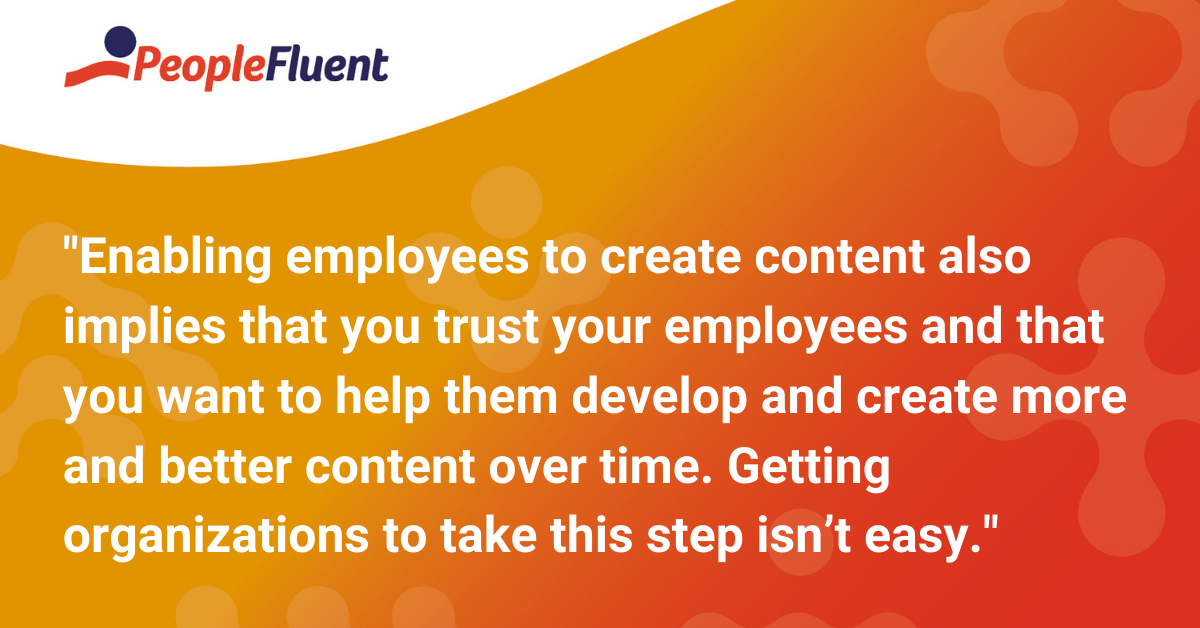Published: Nov 26, 2019Time to read: 5mins Category: Learning
The Future of eLearning: Reclaiming Collaboration Through Digital Technology
Keen to know what the future of eLearning entails? In this post, we discuss how wider technology trends are bringing learners back to the collaborative experiences we have lost in the move to eLearning. We also examine how we can better engage employees as our systems change to suit their needs.
In just 20 years we have seen the corporate learning conversation shift dramatically. Careers that started in a context where instructor-led classroom training was everything are now shaped by the multitude of benefits eLearning has given us. With eLearning, we spend less time traveling and less time investing in the onsite experience. We expend fewer resources reaching the same goal. However, the next 20 years of digital transformation will be shaped as much by what the shift to eLearning has cost us.
In a recent PeopleFluent webinar, we met with Jeff Fissel and Dawn Baron of Instilled, the Learning Experience Platform available within PeopleFluent.
Recommended related reading: 'The 13 Must-Have Features of a Learning Management
Digital Content, Social Influence, Mobile Technology and Their Effect on Employee Learning
The technology we use in our everyday lives will inevitably shape our expectations around corporate learning, and the last two decades are a testament to this. Computer and internet use became ubiquitous, so we shifted to blended learning. Everyone started carrying a smartphone, so we started to deliver mobile learning. Internet use has long-since moved towards a smaller group of social-led venues, so we see corporate learning grappling with the whole idea of social learning.
The challenge when delivering learning is that the traditional corporate LMS still exists outside of these patterns. Today, if we want to find something out, we go to YouTube or Google. That tendency is driving the current wave of corporate learning tools. For most companies, existing tools don’t operate sufficiently. Nor do they present the same opportunities to create, enrich, and share content that newer technologies do.
More from the blog: 'Why a Learning Ecosystem Will Supercharge Your Blended Learning Programs'

Building and Deploying Learning Programs that Drive Continuous Engagement
While we believe that employee-created learning is the next big trend, we’d stop short of saying that it’s coming overnight. Even in businesses for which it has already arrived, the journey was a long one. Johnson Controls, a smart building component manufacturer working with Instilled has thousands of hours of employee-generated video content—a transformational 80 percent of learning content there is created by workers in the field.
However, even the sales discussion that led to that relationship was years in the making. Organizations are reluctant to give up control of their training content to their employees, with all the brand and compliance risks that entails. Meanwhile, employees themselves are initially reluctant to appear on video. In this way, our future approach isn’t just about the tools we build; it’s about the journeys we take to affect wider cultural change.
An employee’s first interaction point with any type of learning can say a lot about an organization’s overall approach. For the vast majority, the learning journey begins during onboarding, and all too often, this is a nightmare of “next-next-next” experiences that tick off various compliance and regulatory obligations. We all have to do these things when we start a new job, but we should also step back and think about what that experience is like for a new person.
You might also like: '5 Reasons Why the ‘Netflix of Learning’ May Be a Bad Idea'

Providing Context to Materials and Workplaces
Small changes pay off in the long term. We can mitigate the prescriptive, impersonal tone of this initial compliance training by doing something as simple as recording a fifteen-second introduction explaining why the content is important to the company and/or the role the employee is taking. Faces on video create a connection between the learner and the company, and can help normalize video as a medium in everyday use.
Enabling employees to create content also implies that you trust your employees and that you want to help them develop and create more and better content over time. Getting organizations to take this step isn’t easy. Many want to route videos and comments through an intensive approval queue, afraid that what will be created will be off-brand, non-compliant, or inappropriate.
Also read: '3 Ways an LMS Takes the Confusion Out of Compliance Issues'

The Importance of Sandboxes (And of Letting Go)
While employees are unlikely to post content that crosses the line—everyone generally understands that certain behavior is no more appropriate on a learning platform than it is in the elevator or via email—technology can reduce the risk. Auto-speech detection can evaluate profanity, and platforms can adhere to visual brand standards.
We see the best results when businesses deploy a sandbox. Every potential creator gets an environment with reduced reach that is monitored frequently, from which moderators can elevate great content to the wider business. This gets employees comfortable with creating content while letting organizations retain an appropriate degree of control.
Ultimately though, the next step in corporate learning will see organizations cede some control to employees. Webcam and smartphone videos are intrinsically informal mediums. But when that informality adds a more human element, it’s possible that it could resonate with learners better than anything we, as learning professionals, can produce.
You might also like: ‘4 Tips for Organizations Using Technology to Train Staff Now Working From Home’
Discover How Learning Builds Skills and Ensures Compliance
Design, deploy, track, analyze, and report on enterprise learning and compliance programs. PeopleFluent helps you execute your programs seamlessly, so employees upgrade their skills and you get results.